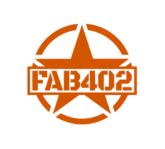Metal Fabrication Terms Glossary
Welcome to FAB402’s metal fabrication glossary. A comprehensive guide to understanding the language of metalworking. Whether you’re a seasoned industry professional or someone new to the world of metal fabrication, this resource will help you navigate the terminology commonly used in our field.
We believe that knowledge is power. Understanding the terminology used in metal fabrication not only enhances communication between our team and our clients but also empowers you to make informed decisions about your projects. Let’s take a look at some key terms:
Metal Fabrication: The process of cutting, shaping, and assembling metal parts to create a final product. This encompasses various techniques such as welding, machining, and forming.
Material Selection: Choosing the appropriate metal alloy or material for a fabrication project based on factors such as strength, conductivity, and corrosion resistance. Material selection impacts the performance and longevity of the final product.
Sheet Metal: Thin, flat metal pieces used in fabrication projects. Sheet metal can be cut, bent, and formed into various shapes and sizes.
Bending: The process of deforming metal by applying force to create angles or curves. Bending is often done using specialized equipment such as press brakes.
Stamping: A manufacturing process that involves pressing a metal sheet into a die to create specific shapes or patterns. Stamping is commonly used in mass production of metal parts.
Finishing: Surface treatment applied to metal parts to improve aesthetics, durability, or corrosion resistance. Common finishing techniques include painting, powder coating, and plating.
Tolerance: The allowable deviation from a specified dimension in a metal part. Understanding tolerance is crucial for ensuring the accuracy and quality of fabricated components.
Fabrication Tolerances: The acceptable range of variations in dimensions or characteristics during the fabrication process. Tight tolerances ensure precise alignment and fit of metal components.
Welding: The process of joining metal pieces together using heat and/or pressure. Common welding methods include MIG (Metal Inert Gas), TIG (Tungsten Inert Gas), and Arc welding.
Welding Joints: The configurations used to join metal pieces together in welding processes. Common welding joints include butt joints, lap joints, and corner joints.
CNC Machining: Computer Numerical Control machining involves using computerized controls to operate machinery for precise cutting, drilling, and shaping of metal components.
CAD (Computer-Aided Design): Software used to create detailed digital models of metal parts or assemblies before fabrication. CAD allows for precise design visualization and analysis.
CAM (Computer-Aided Manufacturing): Software that generates instructions for machining or fabrication processes based on CAD models. CAM streamlines production by automating toolpath generation and optimizing material usage.
Prototype: A preliminary version of a metal part or product used for testing and evaluation before mass production. Prototyping allows for design validation and refinement.
Safety Gear: Protective equipment worn by metal fabricators to prevent injuries during fabrication processes. Safety gear includes goggles, gloves, helmets, and aprons.
Understanding these terms can only improves effective communication between our team and clients but also empowers you to make informed decisions about your metal fabrication projects.
At FAB402, we’re committed to not only delivering high-quality metal fabrication solutions but also fostering a deeper understanding of the industry. We hope this glossary serves as a valuable resource.
Remember, if you ever have any questions or need assistance with your metal fabrication projects, don’t hesitate to reach out to us. We’re here to help bring your ideas to life with precision and expertise.
